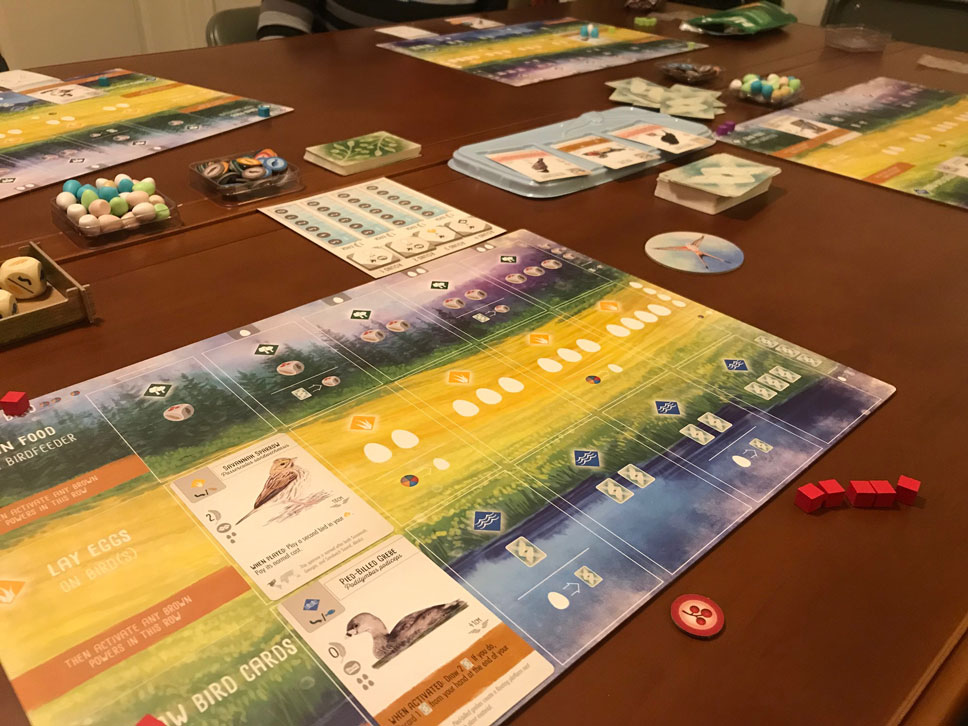Bird Powers
By Katie L. Burke
The board game Wingspan, now available as an app, is both a fun game of strategy and an enjoyable way of learning about the natural history of birds.
March 14, 2022
Science Culture Biology Ecology Nature Conservation
Wingspan. Stonemaier Games, 2019. $60.
I love the idea of learning science through gaming, so I pounced on the board game Wingspan when it came out in 2019. I have a background in conservation biology, and I wanted to see how the game’s creator, Elizabeth Hargrave, had gone about making this science fun.
In Wingspan, as in the popular board game Catan, players gain abilities or modify them to create a unique set of powers. Most such games take place in a fantasy or science fiction realm. Wingspan is unique because it helps players connect with birds they can see in real life. Some of the bird species that are worth the most points in the game are ones that I, as a conservation biologist, get excited to see, such as American woodcocks, trumpeter swans, and black-crowned night herons.

Photo made available by Stonemaier Games.
Each Wingspan player has an ecosystem containing forest, grassland, and wetland habitats and uses food to attract birds to this wildlife preserve. The goal is to maximize your number of points by increasing birds, eggs, and food in each habitat. Players draw cards, each with a gorgeous illustration of a North American bird species, and must figure out how to play to the strengths of the birds in their hand. (Expansion packs of cards for bird species of Europe and Oceania are available.) Some birds require more food, some birds can live only in one particular habitat, some birds are worth more points, and some birds give the player extra powers that can be used when the bird is active during a turn. Usually only one action—gathering food, laying eggs, or drawing new bird cards—can be done during a single turn, unless you have played the card of a bird that gives you an extra power (the ability to activate a food token, for example). That’s where the real strategy comes in.
Because Wingspan play is limited to 26 turns, spread across four rounds, players must build up their bird populations and food supplies quickly in order to win. To boot, in each round you can earn additional points by meeting goals set for that round—such as maximizing the number of bird species you have in a particular habitat, or maximizing the number of eggs laid in a particular kind of nest. You can also earn bonus points at the end of a game if you have met a particular goal that you identified at the outset.
For a beginning player, the learning curve is somewhat steep. The game is intended for players ages 10 years and up, but there are a lot of different pieces and card types to become acquainted with, as you can see in this video demonstrating how the game is played. I found it especially challenging to figure out how to use the cubic pieces meant to keep track of turns in a round, and then I found it hard to remember to use them. Keeping track of my birds’ needs for food and eggs and of my end-of-round and end-of-game goals all felt overwhelming at first. But players who hang in there will soon find themselves enjoying a captivating game of strategy and having fun learning about birds and their natural history.
The Wingspan game app—now available for Android, macOS, and Microsoft Windows as well as for Nintendo Switch and Xbox—removes some of the difficulty by automatically tracking all of the pieces of the game for you. The app also comes with a tutorial that is nicely streamlined to get you over that learning hump.
If you want to experience the flow of the game before joining real players, you can play the board game solo with an automa (a simulated opponent that must follow certain rules) or you can use the app to play against one or more AI opponents and set the level of difficulty of play, starting off with “easy.” (I recommend using the AI if you’re new to Wingspan.) The rudimentary familiarity with the cards thus acquired will help you find your flow. If you want to play against human opponents, you can do so online or by passing your device from player to player.
When playing Wingspan on a phone, you may find it hard to see and read all the necessary parts of the game—the card details, food dice, round goals, food and egg tallies, and bonus cards. Most people, especially those who need reading glasses, will probably have a better experience on a device with a larger screen.
Wingspan is already a big hit: More than a million board games have been sold worldwide. With the move to online and video gaming platforms over the past couple of years, Wingspan is gaining an even wider following. Maybe connecting with birds in this way will inspire more people to get involved with bird conservation.
American Scientist Comments and Discussion
To discuss our articles or comment on them, please share them and tag American Scientist on social media platforms. Here are links to our profiles on Twitter, Facebook, and LinkedIn.
If we re-share your post, we will moderate comments/discussion following our comments policy.